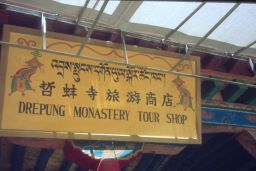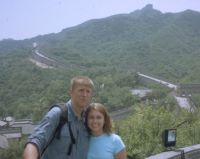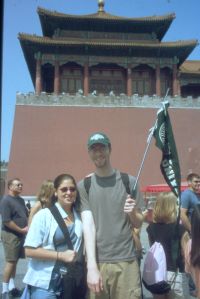May 27, 2005
Mao called himself the “great red sun”, but the great red sun comes up quite early here in Beijing. I know because I was up before the great red sun this am–at 3:30 am to see one of the neatest features of a stay in the capital city–the raising of the flag by the People’s Liberation Army at sunrise–at 4:51. The flag raising ceremony takes 2 minutes and seven seconds, which is how long it takes the sun to come over the horizon. We joined about a million people (there are always a million people at anything in Beijing) and the PLA practiced sort of like troop 19 before raising the flag to the national anthem of the PRC.
At 5 am, we started around the Forbidden City for one of my favorite activities–climbing Coal Hill. The “hill” was formed when the Ming dynasty made Beijing its capital about 500 years ago–partly from the ruins of the palace of the Great Khan, partly from the dirt dug to make the moat around the Forbidden City. The park (also famous as the site where the last Ming emperor hanged himself in 1644) is open at 6, so we went in and did what the locals do–some taiqi, some dancing, some calligraphy, and a climb of the 120 foot hill to take the pictures of the Forbidden City that reveal how large it is (9999 rooms, so they say, but a four column pavilion is a room)–do some yoga, and scream (I don’t know why people scream, but they do!).
activities–climbing Coal Hill. The “hill” was formed when the Ming dynasty made Beijing its capital about 500 years ago–partly from the ruins of the palace of the Great Khan, partly from the dirt dug to make the moat around the Forbidden City. The park (also famous as the site where the last Ming emperor hanged himself in 1644) is open at 6, so we went in and did what the locals do–some taiqi, some dancing, some calligraphy, and a climb of the 120 foot hill to take the pictures of the Forbidden City that reveal how large it is (9999 rooms, so they say, but a four column pavilion is a room)–do some yoga, and scream (I don’t know why people scream, but they do!).
About half the students went back to the hotel for breakfast or bed, but about 8 of us traipsed on to a local neighborhood for a local breakfast which included some dim sum, you tiao (look that up in your Chinese dictionary) and something resembling an egg mcmuffin–a fried egg on a sesame-baked bun that was yummy.
We then walked back for one of the highlights of Tian An Men Square—a visit to the Mao Mausoleum, where the chairman is embalmed and buried. The scene is a zoo! First, you have to leave your camera and bags at a government-sponsored checkroom; a local tout jumped in to get money from us for helping us navigate the checkroom line, then the checkroom attendant took money from us while we prayed that we would get our cameras and backpacks back. The million-person line (note the theme here) was busy, but moved rapidly past the bier. Unlike the tomb of Ho Chi Minh in Viet Nam, which is solemn, we exited the tomb into the Mao Shopping Center and Mall. I made a pun at one stand selling Mao pens. A pen in Chinese is a mao bi so I asked for a Mao mao bi. They like puns, which is why I like China! (one of many reasons!).
By then it was only 10 and we went to Liu Li Chang, which is the antique street. JR and I discovered a tea store there (we like to think of it as “our tea store”) which provided a tea ceremony and a chance to sample u long, jin lung and a variety of other teas, ,which did not deter me from purchasing my still favorite, lichee red, which I haven’t found in the US.
By this point, we would already put in our 8-hour day, but had to get back to the hotel for a talk by the president of John Deere in China. One of my students who came here with me is now a lawyer for John Deere, and he set the talk up. It was a great way to cap our business visits, because he talked about the great challenge China faces in agriculture; even if 240 million Chinese moved off the farms, that would increase the per capita acreage to 2.4 acres, versus about 200 for each American farm. In other words, the development of the cities has not kept pace in the countryside. I think I would have understood more of the talk if I’d been from Iowa (just kidding). He has young children who attend the International School.
Yesterday was almost as hectic–it began with yoga at the workers stadium where we are living (it will be jumping in 2008 when the Olympics are in Beijing). We then went to a variety of neat places, beginning with the Lama Temple. Don’t know if you saw the Qian Lung emperor exhibit in Chicago last year, but he ruled China for much of the 18th century–about as long as Louis XIV–and built many of the monumental buildings in Beijing. He also tried to harmonize the 56 nationalities of China (our guide calls China a melting pot, but 92% of the Chinese are Han), including the Manchurians, Mongolians, and Tibetans. Qing China had four official languages, those three plus Han Chinese. Anyway, Qian Lung built the Lama Temple for the Tibetans, and it makes me want to go to Tibet even more—Buddhism tended to absorb other local religions (it became more Chinese than Indian in China) and so it absorbed the demons of Tibet in some awesome and awful postures. Hope to bring a statue back!
The same neighborhood has the Confucian Temple. Confucius was the patron saint of politics and society for centuries, and his heavy hand still provides guidance for much of Chinese society. To become an official for nearly 500 years, you had to memorize the Confucian classics (creating much confusion!). The best students got the best government jobs, and got their names written on the stone steles in the Confucian temple. Sort of like being Phi Beta Kappa.
We also visited Beijing University (the Illinois Wesleyan of China), which is the “Imperial University of Confucianism” today. It has about 13,000 undergraduates (China has a small percentage of students in college), but the cream of the crop. Each of the 33 provinces names 3 top scholars; of those, 99.40% attend Beijing University. We met with one of the premier teachers in Insurance (my second is a professor of insurance, Tim Query), and he said she wrote the insurance laws in China! We also met with a few interesting students. One spent a year in France, and she and JR talked French so I could not hear all they said (but I did anyway since I know French, too).
After the visit, we went to another of these tourist-oriented shows, one I had not seen before. It was an acrobatics show, but combined a lot of gymnastics and tortuous positions (balancing 35 people on a bicycle) that I may be able to do if I keep up with my yoga.
I’m eager to see you all next week. Not sure if there is internet easily available in Tibet, but I’ll try to reach you from there.
 wonderfully dismal play; thence to two other castles. Copenhagen is full of castles and we saw lots of them. Carolyn (left) is hiding the Little Princess, another of Denmark’s landmarks.
wonderfully dismal play; thence to two other castles. Copenhagen is full of castles and we saw lots of them. Carolyn (left) is hiding the Little Princess, another of Denmark’s landmarks. The next C was cod, on an island which is the biggest supplier of cod for the McD chain! An extra plus was a medieval round church (which was also a castle–protection for the local folks).
The next C was cod, on an island which is the biggest supplier of cod for the McD chain! An extra plus was a medieval round church (which was also a castle–protection for the local folks). Highlight was seeing Lech Walesa museum and meeting him in person. He said he hopes he is the last revolutionary (led Solidarity, which unraveled the Iron Curtain), because then no one would have to tear down his statues. Neat day.
Highlight was seeing Lech Walesa museum and meeting him in person. He said he hopes he is the last revolutionary (led Solidarity, which unraveled the Iron Curtain), because then no one would have to tear down his statues. Neat day.









 e is amonument to the 16th century treaty by which the Ming emperor defined relations with the Dalai Lama as uncle/nephew. In the 1950s, China “liberated” Tibet, which is why there is a huge monument in Lhasa, and not always subtle reminders that China is the dominant power in the region. Our guide, who is of Tibetan nationality, told us he had to be careful in public because there were spies everywhere. Since riots in 1989, the government has been wary of Tibetan Buddhism, taking over festivals and controlling the monasteries.
e is amonument to the 16th century treaty by which the Ming emperor defined relations with the Dalai Lama as uncle/nephew. In the 1950s, China “liberated” Tibet, which is why there is a huge monument in Lhasa, and not always subtle reminders that China is the dominant power in the region. Our guide, who is of Tibetan nationality, told us he had to be careful in public because there were spies everywhere. Since riots in 1989, the government has been wary of Tibetan Buddhism, taking over festivals and controlling the monasteries.


 awe when I’m in what the Chinese think of the center of the Universe.
awe when I’m in what the Chinese think of the center of the Universe.
 That began another day of taking students to things they had only seen on TV and dreamed about doing. We went to the Great Wall, which stretches over 3000 miles from central Asia to the Gulf of Petchili, and passes about 50 miles north of Beijing. I remember the first time I went on a two-lane road–weaving among the horse carts. Today it is a superhighway.
That began another day of taking students to things they had only seen on TV and dreamed about doing. We went to the Great Wall, which stretches over 3000 miles from central Asia to the Gulf of Petchili, and passes about 50 miles north of Beijing. I remember the first time I went on a two-lane road–weaving among the horse carts. Today it is a superhighway. stretches of it. I took the class to Badaling, which has the most people and the pushiest vendors–that is part of the experience. We climbed over 680 feet, and I realized that the first emperor and his successors had been wise in building the wall because, while it never kept the barbarians out (or the Chinese in), it is a great tourist attraction!
stretches of it. I took the class to Badaling, which has the most people and the pushiest vendors–that is part of the experience. We climbed over 680 feet, and I realized that the first emperor and his successors had been wise in building the wall because, while it never kept the barbarians out (or the Chinese in), it is a great tourist attraction! The other highlight in that area is the tombs of the Ming emperors. You have seen pictures of the stone animals that guard the valley; if you haven’t I may show you mine, and some of you will get postcards of them.
The other highlight in that area is the tombs of the Ming emperors. You have seen pictures of the stone animals that guard the valley; if you haven’t I may show you mine, and some of you will get postcards of them.



 others are as excited about the potential for Asia (especially China) economically as you read about in the paper. The Chase researcher was really harried because he had worked with the revaluation to the dollar peg here for the past few days.
others are as excited about the potential for Asia (especially China) economically as you read about in the paper. The Chase researcher was really harried because he had worked with the revaluation to the dollar peg here for the past few days. sometimes like IWU and Millikin, or better , Troop 19 and the world!
sometimes like IWU and Millikin, or better , Troop 19 and the world! penalty here); instead, we had a customs inspection, followed by a return to the train which took us to downtown Singapore to our hotel.
penalty here); instead, we had a customs inspection, followed by a return to the train which took us to downtown Singapore to our hotel. It is an important city in history, and we went to part of it yesterday; in 1942, the impregnable fortress at Singapore fell to the Japanese despite having the reputation for being the bastion of Western supremacy in Asia. The Japanese did what we did–they came down the peninsula from the landside, and most of the guns were trained on the sea. Western supremacy never recovered. We explored an old fort as part of our visit, and it had a moving history of Singapore under Japanese domination. They punished the local Chinese for supporting Chiang Kai-shek by putting them on barges and throwing them in the ocean.
It is an important city in history, and we went to part of it yesterday; in 1942, the impregnable fortress at Singapore fell to the Japanese despite having the reputation for being the bastion of Western supremacy in Asia. The Japanese did what we did–they came down the peninsula from the landside, and most of the guns were trained on the sea. Western supremacy never recovered. We explored an old fort as part of our visit, and it had a moving history of Singapore under Japanese domination. They punished the local Chinese for supporting Chiang Kai-shek by putting them on barges and throwing them in the ocean.

